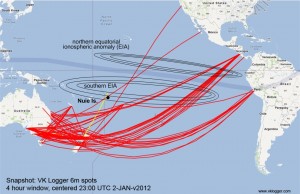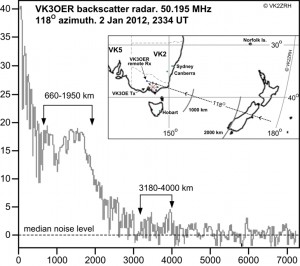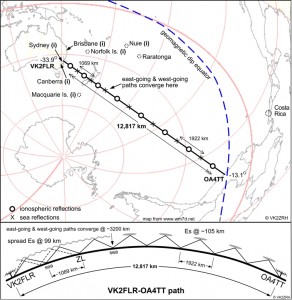I see a few sceptics have gathered.

First, let me expand on a point a made earlier.
Indeed, on 6m, most long-haul DX happens via multi-hop Es, which is not hung-up on the vagaries of the solar cycle.
I have trawled through many dozens of reports of long-haul 6m DX in AR magazine, Six News (UKSMG), DUBUS and QST et al going back to 2005, covering many 100s of contacts and propagation paths. Reports of propagation paths that are clearly NOT F-layer outnumber the F-layer supported paths by a LARGE factor. And the reports continued in a stream right through the looong solar minimum. A 6m propagation path that crosses the geomagnetic equator
may be supported by the high-density 'bulges' of the Equatorial Ionospheric Anomaly (EIA).
The EIA deserves a quick explanation here. Solar radiation causes plasma (ions and electrons) in the E and F regions over the geomagnetic equator to move up across the Earth's magnetic field lines, which are horizontal here. This sets up a complex process called the 'Fountain Effect', such that the plasma reaches high in the F-region and then flows north and south along the magnetic field lines, accumulating into enormous ‘bulges’ in the F2 region that generally extend from about 10deg to 30deg geomagnetic latitude to the north and south of the geomagnetic equator. The anomaly zones enlarge (in latitude and longitude) and become denser as the day progresses and they move westward, following the Sun. The EIA dissipates after the Sun sets on the ionosphere.
Around the equinoxes, the EIA bulges are pretty symmetrical, while around the solstices, they’re not. In the northern summer, the northern EIA is large and dense, while the southern one is small and less dense; vice-versa in the southern summer. As most 6m ops know, the two EIA zones support daytime 6m chordal-hop TEP, most often around the equinoxes, but also outside those seasons at times, depending on favourable solar and ionospheric conditions.
Some Long-Haul Paths Examined
I have analysed quite a number of reported propagation paths, using available ionospheric data, antenna and Tx/Rx parameters etc, to determine how the signals went from one location to another.
On 8 Jan 2014, Mick VK2BZE posted:
I find the multihop E theory hard to swallow, on 2 occasions I have worked 50 watts 5 elem 14 metres asl to central America. That is six and a quarter E hops. I cannot comprehend six E clouds being present in the right places across the Pacific and over a 7 hour time zone span. This involves the sun creating E clouds over this time and it mainly peaks at midday. I don't know about the quarter hop. The signal left from six hops at 50 watts would not even give a WSPR contact. Help me.
Well Mick, and others, let's see if you can swallow the following. Below is a snapshot of VK Logger 6m spots over four hours around 2300 UTC on 2Jan12 (courtesy Adam VK4GHZ). 6m opened from 0000 UT to Costa Rica and Panama. TI5XP (EK70NM), worked into VK2, VK4 and VK5. TI7/N5BEK (EK70CK) worked into VK4, VK5 and VK7, followed by TI2KI/8 (EJ79) into VK2. HP3TA in Panama (EJ88) worked into VK3. XE2HWB worked into VK2 and VK3. In the midst of the action, the previous day’s US stations in EM00 worked into VK2, VK3, VK5 and VK7, picking up ZL contacts along the way.

- Snapshot of 6m DX paths around 2300 UTC 2Jan2012
Note the nested ovals of the northern and southern EIA regions. These are 'representative' of the geographic positions of the bulges, which increase in density towards the centres.
All the above contacts crossed the EIA and the reported characteristics are typical of TEP - even though well outside the equinoctial period (Feb-April).
The ionosonde on Niue Island lies pretty much beneath the southern EIA. The combination of foF2 values and height of the F2 layer over the period the contacts occurred showed the necessary conditions to support TEP. There are many obvious Es paths between VK-ZL, while E51EME on Raratonga worked into eastern VK and to ZL - clearly, via Es. So the paths from USA, Mexico and Central America were most likely Es-extended, skewed-path TEP. The ionosonde on Niue Island lies pretty much beneath the southern EIA. The combination of foF2 values and height of the F2 layer over the period the contacts occurred showed the necessary conditions to support TEP.
But the paths running from Peru across the South Pacific to ZL and VK are clearly well outside the EIA zones.
At 2158 UT, 2 January, OA4TT (Canete, Peru) worked VK4DDC, followed a minute later by E51EME (BG80CT) on Raratonga, Cook Islands. 6m was open between VK and ZL, and in the half hour after 2200 UT, OA4TT worked VK2OT, ZL2TPY, ZL1NX, ZL3ADT, VK4WTN, VK2FLR, VK4HJ and VK4CZ. Distances extended from 8870 km (E51EME) to 13,239 km (VK4WTN). The time difference between OA4TT and eastern VK is 9 hours – morning in VK (and ZL) and afternoon in Peru, which fits the ‘classic’ summer solstice short path (SSSP), or “extreme range east-west” Es (EWEE), propagation pattern.
This event provided an opportunity to characterise the OA4TT-VK/ZL path, based on the methodology I have detailed online in a posting titled,
Signal Strengths of VHF sporadic E propagation, at:
viewtopic.php?f=43&t=10336
This methodology enables the determination of total transmission path losses for Es propagation. For the exercise, my friend of 40 years, Mike VK2FLR, provided key details of his contact and station equipment. OA4TT’s qrz.com pages provided details of his station. IPS ionosondes at the VK end, the Jicamaraca ionosonde in Peru (a little north of OA4TT), along with a backscatter radar sounding by VK3OER added useful information. The backscatter sounding below, rather later than the excitement, clearly shows contiguous multi-hop Es from 660 km out to 4000 km (east of ZL).

- Backscatter Radar sounding from VK3OER on 2Jan2012, 2324 UTC.
The VK2FLR-OA4TT path is 12,817 km long. The usual rule-of-thumb would indicate 6-hop Es at 2137 km per hop, close to the limiting case maximum (zero raypath elevation angle). I analysed the likely path characteristics at the VK-ZL end based on ionograms from IPS stations in the area, which showed sufficient Es electron density, with the Es height at 99 km. From VK/ZL to Peru, across the South pacific region, Es events most often occur at 105 km height, based on studies of radio occultation of GPS signals. So I constructed a likely vertical profile of the propagation path, which yielded
8 hops, Es all the way. A check against the passage of the southern EIA bulge showed that the last hop or two closest to OA4TT were quite unlikely to be F2 skip as electron densities that late in the day near South America would not have supported 50 MHz. The geographic path and profile are shown below.

- An example of long-haul, multi-hop Es propagation.
OA4TT was running 1 kW to an 8-element Yagi at 20 metres height, while VK2FLR was running around 100 W to a 3-element Yagi at 10 metres height at his inner-city location of Glebe Point, in Sydney.
The VK2FLR-OA4TT transmission path loss analysis gave a S/N ratio for OA4TT at VK2FLR of 18 dB, confirmed by VK2FLR (quote: “S3 by ear” – Mike’s an experienced operator). Could it have been 7 hops? The analysis gave a negative SNR! Could it have been more hops? At raypath elevation angles best suited to the antenna elevation radiation angles at each end, the path would be 12 hops, but losses reduce the SNR well below that reported.
I trust you find the above informative, Mick (and others).